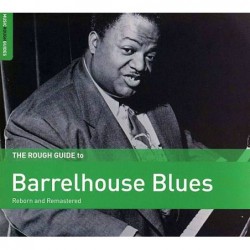





Polityka prywatności

Zasady dostawy

Zasady reklamacji
Country Blues / Traditional Blues
premiera polska: 2018-12-12
kontynent: Ameryka Północna
kraj: USA
opakowanie: Gatefoldowe etui
opis:
Editor's info:
The term ‘barrelhouse’ derives from the cheap bars or ‘juke joints’ of the rural South where African-American labourers gathered to drink and dance at the edge of small towns and levee camps. It was in these rough wooden shacks where the liquor was served directly from the barrels that the piano came into its own, as roving musicians hammered out high-spirited tunes for the drinkers and dancers and got the bar swinging. In turn, the style of up-tempo piano blues that developed in these establishments came to be known as barrelhouse.
The raucous playing style of the opening track by Speckled Red perfectly sets the scene for this rough and ready world, with his classic ‘The Dirty Dozen’ being based on a game of exchanges of insults and vulgar remarks that have long been a part of African-American folklore. In some respects a precursor of rap music, he was told to ‘clean it up for the record’.
Barrelhouse piano developed around the same time as ragtime in the late 19th century, and both shared the same syncopated emphasis on the offbeat. However, this is where the similarity ends as unlike the foot taping 2/4 “oompah” type rhythm of ragtime, the left hand in the barrelhouse style had a walking and train-like quality that created a tension and excitement that made you want to dance. Cow Cow Davenport was a real pioneer of the style, and whilst his seminal 1928 recording of ‘Cow Cow Blues’ owed much to a ragtime style, it was perhaps the first recorded example of the style that was to become known as ‘boogie-woogie’, with its infectious left-hand bass pattern and right-hand melodic improvisation. Within months, Clarence “Pinetop” Smith recorded ‘Pinetop's Boogie Woogie’, which was the first known use of the term ‘boogie-woogie’ on a record and cemented the term as the moniker for the genre. Consisting entirely of instructions to dancers, ‘Pinetop's Boogie Woogie’ was adapted by Ray Charles for his song ‘Mess Around’. Tragically shot by a stray bullet in a club shooting in 1929, Smith’s fame was short lived, however he was acknowledged as a key influence by other boogie-woogie pianists of the time such as Albert Ammons and Pete Johnson, who along with Meade “Lux” Lewis performed at the legendary “Spirituals To Swing” concert at Carnegie Hall in 1938 and went on to enjoy success during the boogie-woogie heyday of the early 1940s.
Unlike the guitar, you couldn’t ride the rails or hobo around with a piano on your back, so musicians would have to adapt to whatever beat-up piano was on offer, with the general state of disrepair adding to the rough and unpolished sound in true barrelhouse spirit. Skip James had the best of both worlds and although primarily thought of as a legendary country blues guitarist, he was in fact equally at home on the piano, as proven by his unique piano style on ‘If You Haven’t Any Hay Get On Down The Road’.
Other popular blues pianists to emerge from the barrelhouse circuit include Jimmy Yancey, Roosevelt Sykes and Cripple Clarence Lofton, an artist famed for his energetic stage presence. Although born with a limp, from which he derived his stage name, it could be said that it was somewhat exploitative as he started his career as a tap dancer. Lofton’s rough and ready approach is in great contrast to other featured gems including the precise ragtime-infused playing of Will Ezell on ‘Heifer Dust’ and Walter Roland’s slick accompaniment to ‘Watcha Gonna Do?’, his comical duet with blues diva Lucille Bogan. Leroy Carr was another incredibly influential blues piano pioneer whose life was cut short in 1935 by acute alcoholism, and here he closes out the album with his long-time sidekick Scrapper Blackwell on the fittingly titled ‘Barrelhouse Woman’.
utwory:
1. Speckled Red: The Dirty Dozen 3:11
2. Jimmy Yancey: Slow And Easy Blues 2:32
3. Cripple Clarence Lofton: Strut That Thing 2:56
4. Will Ezell: Heifer Dust 2:57
5. Walter Roland: Watcha Gonna Do? 2:57
6. Cow Cow Davenport: Cow Cow Blues 3:08
7. Romeo Nelson: Head Rag Hop 2:56
8. Roosevelt Sykes: 32-30 Blues 3:07
9. Clarence "Pinetop" Smith: Pintop's Boogie Woogie 3:10
10. Skip James: If You Haven't Any Hay Get On Down The Road 2:52
11. Turner Parrish: Fives 3:16
12. Bert Mays: You Can't Come In 3:06
13. Meade Lux Lewis: Honky Tonk Train Blues 2:58
14. Charlie Spand: Soon This Morning Blues 2:56
15. Herve Duerson: Avenue Strut 2:47
16. Victoria Spivey: Hoodoo Man Blues 2:36
17. Henry Brown: Henry Brown Blues 2:57
18. Little Brother Montgomery: Vicksburg Blues 2:56
19. Jabo Williams: Pratt City Blues 2:57
20. Pete Johnson & Albert Ammons: Barrelhouse Boogie 3:01
21. Bob Call: 31 Blues 2:39
22. Freddie "Redd" Nicholson*: You Gonna Miss Me Blues 3:03
23. Montana Taylor: Detroit Rocks 3:19
24. Louise Johnson: On The Wall 3:00
25. Leroy Carr & Scrapper Blackwell: Barrelhouse Woman No.2 2:39
wydano: 2018-09-28
more info: www.worldmusic.net
Opis